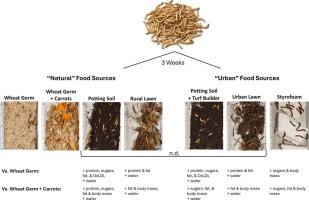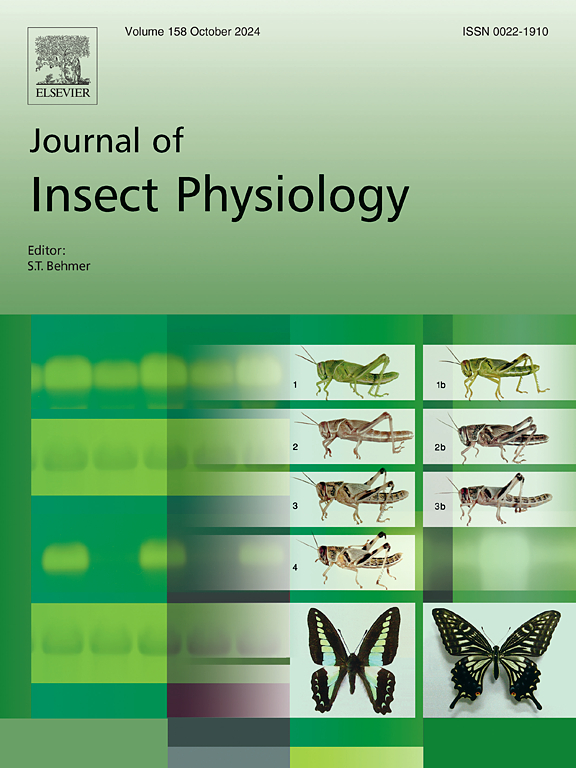Urban substrates alter the nutritional composition of an emerging model insect, Tenebrio molitor
IF 2.3
2区 农林科学
Q1 ENTOMOLOGY
引用次数: 0
Abstract
Although mealworms (Tenebrio molitor) typically consume grains, studies reveal they also consume decaying plant matter, animal waste, and even plastics. The goal of this work was to study mealworms as an emerging model organism to understand how feeding in an urban environment impacts the nutritional composition of insects. We evenly divided 3500 mealworms among each of the following seven substrates designed to model potential food sources in urban versus more natural areas: wheat germ (control); Styrofoam (STY); mixture of soil, grasses, and leaves from urban (UL) or rural lawns (RL); wheat germ with carrot slices (WG + CAR); and organic potting soil in the absence (PS) or presence of Turf Builder (PS + TB). Mealworms were fed for three weeks, after which we measured whole body mass, protein, crude fat, total sugars, glucose, water, and oxidized lipoproteins. No significant differences in nutrient composition were found between mealworms fed soil or lawn substrates. Mealworms fed PS, PS + TB or WG + CAR had lower oxidized lipoproteins compared to the WG diet, likely attributed to antioxidants present in PS and carrots. Mealworms consuming soils or lawns were relatively deficient in proteins, fats, and sugar nutrients compared to WG or WG + CAR, although they maintained higher water content. In contrast, mealworms consuming Styrofoam contained less dietary fat and total sugars than WG or WG + CAR, and less water, but more crude fat, than either soil substrate. These findings demonstrate that mealworms consuming urban-associated substrates (i.e. potting soil, lawns, Styrofoam) are nutritionally deficient compared to those consuming wheat germ with or without carrots.

城市基质改变了新兴模式昆虫黄粉虫的营养成分。
虽然粉虫(tenbrio molitor)通常吃谷物,但研究表明它们也吃腐烂的植物、动物粪便,甚至塑料。这项工作的目的是研究粉虫作为一种新兴的模式生物,以了解城市环境中的摄食如何影响昆虫的营养成分。我们将3500只粉虫均匀分布在以下七种基质中,这些基质旨在模拟城市与更自然地区的潜在食物来源:小麦胚芽(对照);聚苯乙烯泡沫塑料(妓院);城市(UL)或农村草坪(RL)的土壤、草和树叶的混合物;胡萝卜片小麦胚芽(WG + CAR);在没有(PS)或有草坪建设者(PS + TB)的情况下使用有机盆栽土。喂食粉虫三周后,我们测量了全身质量、蛋白质、粗脂肪、总糖、葡萄糖、水和氧化脂蛋白。粉虫饲喂土壤和草坪基质的营养成分无显著差异。喂食PS、PS + TB或WG + CAR的粉虫的氧化脂蛋白较WG饮食低,这可能归因于PS和胡萝卜中存在的抗氧化剂。与WG或WG + CAR相比,消耗土壤或草坪的粉虫相对缺乏蛋白质、脂肪和糖营养物质,尽管它们保持较高的水分含量。相比之下,食用聚苯乙烯泡沫塑料的粉虫的日粮脂肪和总糖含量低于WG或WG + CAR,水分含量低于WG或WG + CAR,但粗脂肪含量高于两者。这些发现表明,食用与城市相关的基质(即盆栽土壤、草坪、聚苯乙烯泡沫塑料)的粉虫比食用有或没有胡萝卜的小麦胚芽的粉虫营养不足。
本文章由计算机程序翻译,如有差异,请以英文原文为准。
求助全文
约1分钟内获得全文
求助全文
来源期刊

Journal of insect physiology
生物-昆虫学
CiteScore
4.50
自引率
4.50%
发文量
77
审稿时长
57 days
期刊介绍:
All aspects of insect physiology are published in this journal which will also accept papers on the physiology of other arthropods, if the referees consider the work to be of general interest. The coverage includes endocrinology (in relation to moulting, reproduction and metabolism), pheromones, neurobiology (cellular, integrative and developmental), physiological pharmacology, nutrition (food selection, digestion and absorption), homeostasis, excretion, reproduction and behaviour. Papers covering functional genomics and molecular approaches to physiological problems will also be included. Communications on structure and applied entomology can be published if the subject matter has an explicit bearing on the physiology of arthropods. Review articles and novel method papers are also welcomed.
 求助内容:
求助内容: 应助结果提醒方式:
应助结果提醒方式:


